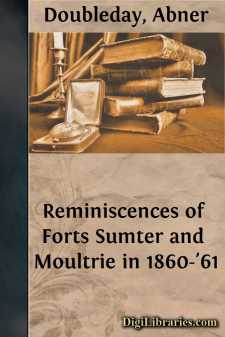Categories
- Antiques & Collectibles 13
- Architecture 36
- Art 48
- Bibles 22
- Biography & Autobiography 813
- Body, Mind & Spirit 142
- Business & Economics 28
- Children's Books 15
- Children's Fiction 12
- Computers 4
- Cooking 94
- Crafts & Hobbies 4
- Drama 346
- Education 46
- Family & Relationships 57
- Fiction 11828
- Games 19
- Gardening 17
- Health & Fitness 34
- History 1377
- House & Home 1
- Humor 147
- Juvenile Fiction 1873
- Juvenile Nonfiction 202
- Language Arts & Disciplines 88
- Law 16
- Literary Collections 686
- Literary Criticism 179
- Mathematics 13
- Medical 41
- Music 40
- Nature 179
- Non-Classifiable 1768
- Performing Arts 7
- Periodicals 1453
- Philosophy 64
- Photography 2
- Poetry 896
- Political Science 203
- Psychology 42
- Reference 154
- Religion 513
- Science 126
- Self-Help 84
- Social Science 81
- Sports & Recreation 34
- Study Aids 3
- Technology & Engineering 59
- Transportation 23
- Travel 463
- True Crime 29
Reminiscences of Forts Sumter and Moultrie in 1860-'61
by: Abner Doubleday
Categories:
Description:
Excerpt
CHAPTER I.
FORT MOULTRIE IN 1860.
The Garrison of Fort Moultrie.—Early Indications of Secession.—Situation of the Fort.—Edmund Ruffin and Robert Barnwell Rhett.—The Secretary of War.—Arms sent to the South.—Colonel Gardner.—Captain Foster ordered to Charleston Harbor.—The Officers at Fort Moultrie.—Communications with Northern Men by Cipher.—Proscription of Antislavery Men in Charleston.—Position of Charleston Merchants.—The Secession Leaders only prepared to resist Coercion.—The Mob proves unmanageable.—General Scott's Letter to the President, October 29.—The Situation in November.—No Instructions from Washington.—Colonel Gardner's Report to General Wool.
The summer of 1860 found me stationed at the head-quarters of the First United States Artillery at Fort Moultrie, South Carolina. I was captain of Company E, and second in command to Brevet Colonel John L. Gardner, who was lieutenant-colonel of the regiment. The regimental band and Captain Truman Seymour's company (H) also formed part of the garrison. The other forts were unoccupied, except by the ordnance-sergeants in charge.
Charleston, at this period, was far from being a pleasant place for a loyal man. Almost every public assemblage was tinctured with treasonable sentiments, and toasts against the flag were always warmly applauded. As early as July there was much talk of secession, accompanied with constant drilling, and threats of taking the forts as soon as a separation should occur.
To the South Carolinians Fort Moultrie was almost a sacred spot, endeared by many precious historical associations; for the ancestors of most of the principal families had fought there in the Revolutionary War behind their hastily improvised ramparts of palmetto logs, and had gained a glorious victory over the British fleet in its first attempt to enter the harbor and capture the city.
The modern fort had been built nearly on the site of the ancient one. Its walls were but twelve feet high. They were old, weak, and so full of cracks that it was quite common to see soldiers climb to the top by means of the support these crevices afforded to their hands and feet. The constant action of the sea-breeze had drifted one immense heap of sand against the shore-front of the work, and another in the immediate vicinity. These sand-hills dominated the parapet, and made the fort untenable. Indeed, it was originally built by the engineers as a mere sea-battery, with just sufficient strength to prevent it from being taken by a coup de main. As an overpowering force of militia could always be summoned for its defense, it was supposed that no foreign army would ever attempt to besiege it. The contingency that the people of Charleston themselves might attack a fort intended for their own protection had never been anticipated.
Our force was pitifully small, even for a time of peace and for mere police purposes. It consisted of sixty-one enlisted men and seven officers, together with thirteen musicians of the regimental band; whereas the work called for a war garrison of three hundred men.
The first indication of actual danger came from Richmond, Virginia, in the shape of urgent inquiries as to the strength of our defenses, and the number of available troops in the harbor. These questions were put by a resident of that city named Edmund Ruffin; an old man, whose later years had been devoted to the formation of disunion lodges, and who became subsequently noted for firing the first gun at Fort Sumter. His love of slavery amounted to fanaticism. When the cause of the Rebellion became hopeless, he refused to survive it, and committed suicide.
In the beginning of July, Robert Barnwell Rhett, and other ultra men in Charleston, made violent speeches to the mob, urging them to drive every United States official out of the State; but as many influential Secessionists were enjoying the sweets of Federal patronage under Buchanan, we did not anticipate any immediate disturbance....


